![[Culture & Arts]](Culture%20&%20Arts.jpg)
Legend of the AMBALAMA
Arul Sathya
|
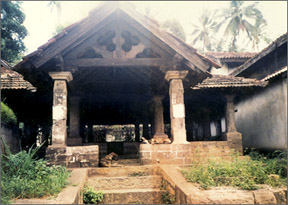
HERITAGE: The ambalama built by Vythiingam Pillai.
Picture by H. M. Mansoor
|
TAMIL CULTURE: If you happened to travel to Digana in Kandy via
Pallekelle, you would come across a small town known as Kengalla and at
the bus halt on your left, you will not miss a small building without
doors.
It is an ambalama built in 1907, exactly 100 years ago by a Tamil
planter from Tanjur, Tamil Nadu and member of Nayak dynasty who ruled
the Kandyan Kingdom from 1739 to 1815. This 100-year-old ambalama has an
interesting story combined with historical facts.
This ambalama distinguish itself from others in Kandy because it is
built with a stone floor and stone pillars and is roofed with country
tiles. It consists of two rooms probably one for men and another for
female travellers.
Maheswaran M.A. senior assistant librarian of the University of
Peradeniya says that these rooms may have been built on a caste basis,
one for higher and another for lower.
Vythilingam Pillai, who came from Tanjur, Tamil Nadu, via Gampola to
Pallekelle to reside, built this ambalama and also constructed a similar
ambalama at Anjukade (five shops), Theldeniya. This ambalama and the
Anjukade area went under water when the Victoria dam was built across
the Mahaweli.
The Tanjur connection with the Kandyan kingdom begins in 1604 with
the Tamil speaking Nayak soldiers and the traders slowly moving into
Kandy and beginning to settle in the Dumbara valley.
When King Narendrasingha who accented to throne in 1707, handed over
the throne to his Nayak queenâs brother Vijayarajasinghe and it was the
time the Kingdom finally fell on the hands of Nayak dynasty.
During this period Dumbara valley was an arable land where rice was
produced and the Chetty traders form Tanjur built up a farming industry
using the grass land of Pallekelle, Kengalle, Theldeniya and the farming
activities went up to Hanguranketa. Maheswaran points out that the
original name of Kengalla was known as Gongalla where cattle were reared
and the Milk business was flourishing.
The Chetty traders who owned shops and go-downs at Chetty street
later known as Trincomalee street in Kandy had their residences back at
Pallekelle and the Kengalla areas which would have been more suited for
farming and quiet family life, he further said.
âWhen the last King of Kandy was expelled from the throne, the King,
his family members and the Nayak relatives were deported to Vellore,
South India.
The Chettiars and the milk traders were allowed to go on with their
life because the British needed flesh and milk as their stable food.
During this period, around 1840, Vythilingam Pillai emerges from Tanjur
and settles in Kengalla where his grandfather reared cattle.
It was the time where coffee was introduced and began to earn money
for the British which also called for more South Indian labourers into
the Island and they were moving in to Kandy hills in thousands on feet
or by carts.
When disease began to spread to the coffee industry, these Chettiars
got involved in multi crop cultivation. Then came the tea industry which
once again called for thousands of Indian labourers. These labourers
brought to Kandy under Kangany system, were distributed among the tea
estates in
and around Kandy. Around this period (1907) Vythilingam who owned
acres of mixed crop land in and around Kengalla built two ambalamas one
in Kengalla and other in Theldeniya.â Maheswaran explains.
As Pallekelle and Kengalla area were filled with multi crops and
grass land with plenty of water, and also was a main route to many tea
estates, it was natural for the road going across Kengalla to be busy
with labourers, traders and passing passengers, this man Vythilingam
Pillai who had a royal connection, may have decided on building an
ambalama at Kengalla where carters and passengers and the bulls could
take an overnight rest.
If you travel further up the pansala road beginning at the ambalama
which lead up to Manikinna, you would be able to witness large old
houses built on acres of land with mixed crops still belonging to
descendents of Vythilingam and Chettiars.
âIf you happen to buy a plot of land in this area you would notice
the title deed of the land reveals that it was originally owned by some
chettiars or Pillais, traders or farmers of that Nayak periodâ
elaborates Maheswaran.
âBefore submerging of the Theldeniya ambalama under Mahaweli, the
pillars of ambalamawere removed and relocated at Balagolla Kali temple
where they can be seen today,â Rewathi, a descendent of Vythilingama
explained.
This ambalama at Kengalla which has a colourful history is
totallyneglected today. It has become an ideal residence for stray dogs
and cattle. Vythilingam Pillaiâs portrait still hangs from descendantâs
pooja rooms but these families show even less willingness to keep the
ambalama clean and safe.
âOutcastâ: A battle with inner conscience
|
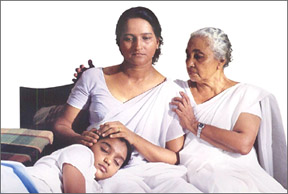
JUSTICE VS. INJUSTICE: Scenes from Aaganthukaya
|
CINEMA: Veteran director, Wasantha Obeysekaraâs newest venture is
indeed a film worth talking about. Backed up by good acting from a
talented cast, Aaganthukaya (Outcast) brings forth issues on social
ethics; how worthiness clashes with corruption.
The movie begins at its climax with flashbacks to the past embedded
into the present. Sampath (Saumya Liyanage), a principal of a leading
Government school takes after his father who was killed before his eyes
as a result of campaigning against injustice. Unlike others in his
position, Sampathâs world is ruled by ability and fairness not bribery
and politics.
However he soon realises through experience and time that in a world
polluted by political influence, wealth and power, there is little place
for justice. One last step is all that he has to take to break free from
a life he is doomed to lead - a life which goes against his conscience.
A significant fact about the film is its absence of background music.
Obeysekara deserves credit for maintaining the artistic value as well as
his ability to keep the viewers guessing.
Why did Sampath take such a step? How did things turn out to be this
way? Is there no justice to this system? How can good survive evil?
These characters are not fictional but exist in our society - a direct,
bold attack against the prevailing system.
The school is where human beings begin their education - a place
where they are taught values and moulded into their future self. If this
is the situation of such an institution, what more can be said of the
future?
Credits
Directed by: Wasantha Obeysekara
Produced: Anura Obeysekara
Cinematography: Ruwan Costha
Music: Rohana Weerasinghe
Cast: Sanath Gunathillaka
Saumya Liyanage
Chandani Senaviratne
Giriraj Kaushalya
Damayanthi Fonseka
Nimal Anthony
Moments from Roo-Chaya
PHOTOGRAPHY: Roo-Chaya, the fifth photographic exhibition organised
by the Photographic Club of Devi Balika Vidyalaya was held on May 25 and
26 at the Wimal de Silva auditorium.
The guest of honour was the director of non-formal and special
education, H.P.N. Lakshman. Sarath Perera, the well-known photographer
was also present. A range of photographs, under the theme âmoodsâ, done
by students of Devi Balika and students from other schools were
displayed.
|
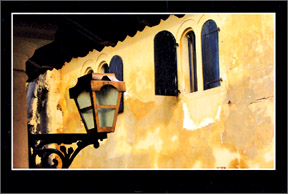
|
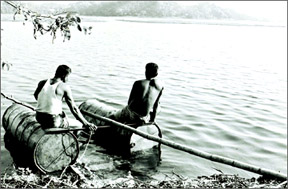
|
|
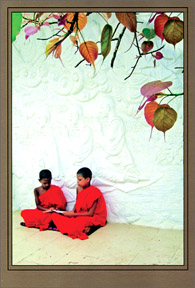
|
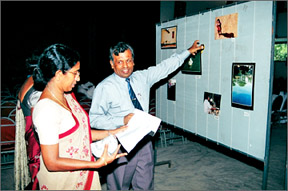
|
|
CAPTIVATING:
Scenes from Roo-Chaya |
Pictures by Palitha Gunasena
|

